Thesis Journal vol.7 wk6 – Thesis Proposal Draft
Thesis Proposal Draft
My main question I want to address in my thesis is how our bodies inform us about ourselves? In particular, starting from my recent study in voice-confrontation, is our recorded voice part of ourselves? Our own voice, through a series of activity of thought initiation as electricity in our brain are transmitting from our internal organ to be an external source. Is our voice an extension to our body? Why are we attached to the “extension” of our body and rely on it to inform who we are?
This project will take shape in a series of experiences to emulate our relationship with our body, starting from the aura and sonic experience as its first stage. In this first experiment, I aim to dissect our aural hearing process and perception, deconstruct its system physically, physiologically and psychologically in order to provide a creative and critical perspective to its fundamental statement. To be able to introduce an intervention to our perception of our own voice and our identity.
To me, it is fair to say that my source of love, joy and health are coming from and co-exist within my body. Thus, my hope is, in revealing a relationship with our own body in a creative perspective. This project is about to explore a sense of self-acceptance and self-care in an ever more digitally self-confront environment.
This project aims to provide an artistic approach in learning self-acceptance and self-care. Hopefully, through the experiments, the audience will be able to build deeper connections to their physical body. Eventually leading to a wider audience who will collectively work on to provide a comprehensive tool kit.
Influences & Inspiration
Questionnaire_
Let’s talk about sound perception – your own voice. This is an anonymous questionnaire to IMA lowres cohort 🙂
My first observation is that people associate their voice as part of their physical body. More than a third of my interviewees expressed dislike of their own voice while only a tenth of responded positively to their own voice. With one of five interviewees turned to like their own voice eventually.
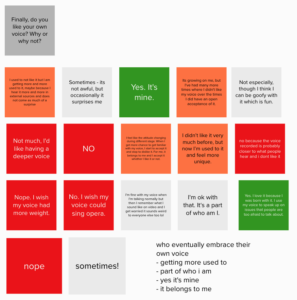
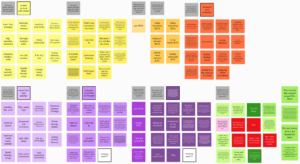
Research_
Physiology and Psychology of the Human Voice (below video) & SONOVOX | Carolyn McGettigan – “The Social Neuroscience of Voices”. This work will address a range of topics including voice identity representation and learning, vocal flexibility and control, voice ownership, and the neural underpinnings of spoken interactions.
Why you don’t like the sound of your own voice | Rébecca Kleinberger – This is an insightful public speech about how human anatomy works in hearing our own voice. There are three filters in our body before we could hearing our own voice. The mechanism of inner voice, inward voice and outward voice shapes our perception toward our identity.
Music and the Voice: Brain Mechanisms of Vocal Mastery and Creativity | Sound Health | Dr. Charles Limb, The Kennedy Center – Dr. Limb presents the results of fMRI scans relating to musicality, improvisation, and brain function. In this study, various topics are touch upon on creativity and the brain reactions in creating and performing music. It is surprised to me to see the brain soothes (deactivation) when performing jazz music (for some of the guest musicians).
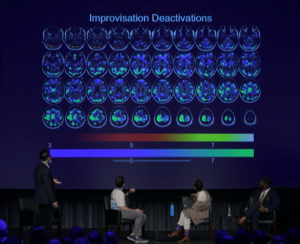
Publication_
Listen to your own voice | Andrew Green –
Do Voices Matter? Vocality, Materiality, Gender Performativity | Annette Schlichter
Theorizing voice: Performativity, politics and listening | Jenny R. Lawy –
body, embodiment | Maggie Hansen – I am curious about what body, bodily and embodiment mean and finding this publication extremely helpful. “McLuhan’s definition of media as bodily extensions establishes the possibility for further bodily alienation. As media build upon each other, telescoping further and further from our human skin, the limits of our body become less and less definable.”
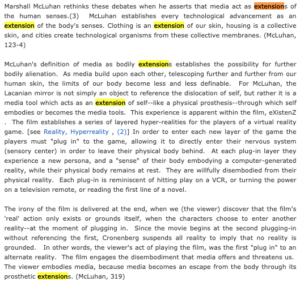
Documentary_
SONOVOX – a device created in 1939 which attached to the throat transformed its sounds in a more metallic ones. It was very used in its first years to create effects in cartoons, also in radio, movies and music shows.
Exhibition_
Sound Bite | Science and Media Museum UK – It this form of introduction with the experiment where you can experience in this museum (is that true?). I find it very welcoming and at the same time explanatory and friction-free. I would very much like to create an experience where people will feel welcome and be able to grab and test intuitively.
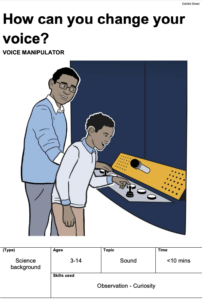
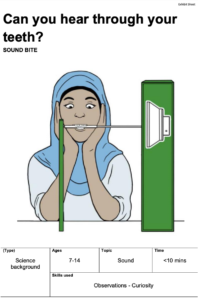
David Bowie Is | V&A – I am not entirely sure how this will link to my topic yet. However, as I personally participated in this show in London in 2013, the whole experience sparks me thinking about David Bowie’s of various artistic role-playing in voice expression, identify and performance as collective memories that we constantly refer to the history of pop music culture.
Project_
Industrial Instruments | Yuri Suzuki
Sound of the Earth: The Pandemic Chapter | Yuri Suzuki
12 Little Spells | Esperanza Spalding… Spotify link – The topic of exploration of the body, human energy and healing via music creation is super interesting to me. To my topic, will it consist of different parts in separate experiments? Can the idea of therapeutic or rejuvenating take part in my thesis work? Why and how?
40 part motet | Janet Cardiff – The sonic experience of site-specific(s) soundscape is fascinating. Effortless storytelling of a 40-part motet. The scale, flexibility and possibility is something that I am looking forward to for a basic set up of sonic environment of sound as sculptural objects.
Solid Light Works | Anthony McCall – It is poetic to me when the light reveals a sense of space, volume and weight. I would hope to know my medium and provide a strong alternative perspective to experience my work. The playful and participatory attributes of the work are something I wish to build in the DNA of my work.
Time Square | Max Neuhaus – To me, this is a powerful project. This sound art project blends in a city and became a part of the city. I wonder if my work will be site specific or adaptive (to gallery or retail for example)? What is the behaviour of my work to the location and where and how it offers interactivities?
Voice Tunnel | Rafael Lozano-Hemmer – I personally see this project taking shape in a participatory approach that enables a great collective experience. The metaphor is transforming voice into light in a tunnel is also fascinating to me. MY wish for my project is that it could be a collective experience without having to join the project in a silo and waiting in a queue.
Artist_
Yuri Suzuki | Sound design artist
My previous project/ experiment as resources to leverage_
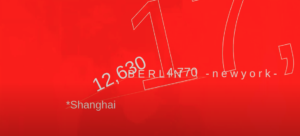
City sound signature weekly experience of collecting sound signatures in the park. With an awareness of data collection, I collected and labeled the audios by their vertical height as objects in space. (A collaborative concept with Monika Lin)
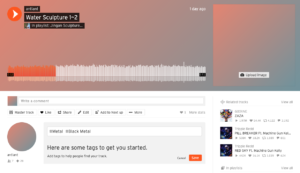
Various reflection sketch for thesis development weekly experience of concept sketching on installation designs. When the recorded image and sound of our physical body are no longer belong to us. The idea of our extended body lead us, confront us and interrogate us came to me in the drawing.

Cornell box for thesis development weekly experience of building Cornell box. The second Cornell box was build on with creating resonance in mind. The resonance space was orchestrated with different heritages of nature. Wood veneers in different texture and grain work collectively and separately to response to energy flows.
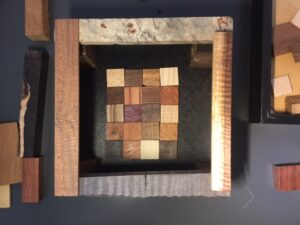
Initial design experience and framework weekly experience of ideating possible experience at the early stage.
A. To resonate by hearing and touch – conscious and reality – An installation where you will experience both sonically and haptically of a sound
B. To comprehend by a huge variety of samples – A sound distorted environment where your own voice is recorded (or altered) in various ways and played in separate channels
C. To dehumanize and cyberize a voice – A space where you can only hear the high or low frequency of a speech
D. To create a confused then enlightened(surprised) moment – Receive a phone call from a stranger who has an identical voice of your own
E. To surprise a familiar moment – Meet someone who has almost identical voice to your mother
F. To create a cognitive dissonance – Experience a car accident simulation where the car is coming at you but you hear the sound from behind
G. To reproduce and recreate – Use your own voice as an atomic property to create objects (How would a generative object look like if we in put our voice with a simulation algorithm?)
H. To transform and explore – Something that alters your own voice
I. To recognize, take advantage and control (your voice) – An application allows you to adjust your own voice in online meetings
J. To mimic, modulate and generate – Voice deep fake (eg with mic that can deep fake your favorite tone?)
K. To empathize and embrace – Love my own voice – how?
(AL: is it the right order? RK: will these be formulated in an organic way?)
Project envision and realization
My goal is to curate experiment(s) that will lead to a collection. I see my possible key steps are. First, to identify experiment(s) I would like to bring to the topic and start to prototype it. I foresee a variety of mixed physical and digital interventions in this curated experience. The first experiment contains a basic interface and interaction designed for a sonic experience. Second, consider bringing the sonic experience to the physical world of interactive objects, wearable devices or installations (big or small) to further strengthen the concept in a tangible way. I assume the scale and lighting could play as strong factors if it will be presented in an installation format.
The project is open to the general public however I am really interested in building accessible interactive art for audiences who are visually impaired or hearing loss audiences in various degrees.
Areas of strength and areas to be explore in depth
My areas of strength are in concept development and design execution. Designing physical objects is something that I am well-versed in.
I see Audio engineering and sound experiment with sensors would be something I will get hands on very soon. Presumably work with microphone and P-Com that will provide feedback with voice input. Welcome to ideas and instructions!
Possible TAGS
#voiceconfrontationart #voiceart #soundart #auralsonicexperiment #selfcare #selfacceptance #identity #body #deeplistening
Po-Wen Shih
Related Posts
Leave a Reply Cancel reply
You must be logged in to post a comment.
Kat Sullivan
Adam Colestock
Helen (Chenuan) Wu
Christina Lan
Dorian Janezic
George Faya
Julia Myers
Kelsie Smith
Michael Morran
Po-Wen Shih
Liu Siyan
Fisher Yu
—
Craig Protzel
Christopher Wray
Haoqi Xia
Hayden Carey
Katherine Nicoleta Helén
Maria Maciak
Parisa Shemshaki
Sakar Pudasaini
Skyler Pierce
Steven Doughty
Yiqi Wang
—
Andrew Lazarow
Benoit Belsot
Enrique García Alcalá
Hongyi Zhang
Jay Mollica
Li Shu
Teddy (Jian) Guo
Monika Lin
Wenye Xie
Yiru Lu
